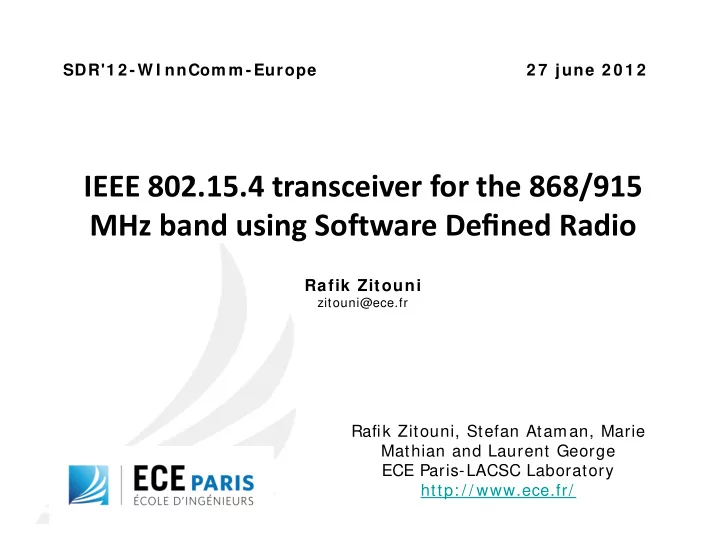

SDR'1 2 -W I nnCom m -Europe 2 7 june 2 0 1 2 IEEE 802.15.4 transceiver for the 868/915 MHz band using Software De fi ned Radio Rafik Zitouni zitouni@ece.fr Rafik Zitouni, Stefan Ataman, Marie Mathian and Laurent George ECE Paris-LACSC Laboratory http: / / www.ece.fr/
Outlines 1. Background of IEEE 802.15.4 PHY specifications 2. Software Implementation on GNU Radio • Software architecture • Transmitter • Receiver 3. Experimental approaches and results 4. Conclusions and perspectives 2
IEEE 802.15.4 PHY specifications IEEE 802.15.4 MAC IEEE 802.15.4 IEEE 802.15.4 868/915 MHz 2450 MHz PHY PHY Low Rate WPAN (LR-WPAN) Simple Low cost Low power consumption E.g. Sensor networks Data rates: 20-40 kbps (868/915 MHz) 250 kbps (2450 MHz) 3
IEEE 802.15.4 PHY specifications PHY (MHz) Frequency Spreading parameters Data parameters band (MHz) Chip rate Modulation Bit rate Symbol rate Symbols (kchip/s) (ksymbol/s) 868/915 868-868.6 300 BPSK 20 20 Binary 902-928 600 BPSK 40 40 Binary 2450 2400-2483.5 2000 O-QPSK 250 62.5 16-ary Orthogonal Channels 1-10 Channel 0 868.3 MHz 928 MHz 902 MHz 2 MHz 4
IEEE 802.15.4 PHY specifications PHY packet structure : Synchronisation Preamble sequence ( 4 Bytes) Start of Frame Delimiter ( 1 Byte) PHR or PHY Header PSDU length (1 Byte) PSDU = FCF+ SeqN+ AddressInf+ Data payload+ CRC-16 PSDU 5
Software Implementation on GNU Radio Software How do i change the implementation of my transcrive parameters transceiver gives me to adapt it to my the flexibility to change requirements these parameters 6
Software Implementation on GNU Radio Why software implementation ? Perfect command of GNU Radio toolbox Hardware implementation of IEEE 802.15.4 transceiver for 868/ 915 MHz band was been done only on ASICs or FPGA Need to control the standard specifications by the flexibility and the ability of the software definition Performances evaluation of the transmissions by changing the physical parameters IEEE 802.15.4 transceiver in 868/ 915 MHz presents wider range than that of the 2450 MHz band for a given link budget Possibility to adapt software transceiver for cognitive radio purposes 7
Software Implementation on GNU Radio Softw are Architecture : GNU Radio flow graphs Transmitter C+ + Block C+ + Sink Block C+ + Block USRP 1 … Python Block Python Sink Block Python Block Parameters adjustement GNU Radio flow graphs receiver C+ + source Block C+ + Block C+ + Sink Block USRP 1 … Python Sink Block Python source Block Python Block Performances evaluation 8
Software Implementation on GNU Radio Transm itter : Transm itter : A new block gr.symbols_to_chips is add to GNU Radio. Symbol spreading is the Direct Sequence Spread Spectrum (DSSS) 9
Software Implementation on GNU Radio Receiver : A new block ieee.ieee802_15_4_packet_sink coombined with gr.diff_decoder_bb is add to GNU Radio. Packet queue is observed by an external python thread 10
Experimental approaches and results Indoor environment 2 USRP 1 with RFX 900 Daughterboards Host computer with one Core 2 Duo CPU running at 2.4GHz and 2 GB of RAM. Distance between the two USRP1 boxes was bigger than 2 meters. Decimation D and Interpolation I of respectively USRP receiver and USRP transmitter are : _ 128 DAC s MSPS DAC _ s ADC _ s I [ 16 , 20 , 24 ,..., 508 , 512 ] , I D . . r sps r sps ADC _ s 64 MSPS [ 8 , 10 , 12 ,..., 254 , 256 ] D 11
Experimental approaches and results Bit rate Sampling Decimation D Interpolation 868.3 MHz 20 kbps 16 sps 200 400 916 MHz 40 kbps 8 sps 200 400 Power spectrum of our software transceiver recorded with the USRP 12
Experimental approaches and results Receiver symbol constellation 13
Experimental approaches and results The BER versus received SNR for central frequency 868.3 MHz and for the MFB 14
Experimental approach and results The PER over received SNR using two central frequencies 916 MHz and 868 MHz 15
Conclusions and perspectives Here we present the implementation of the IEEE 802.15.4 standard on a SDR transceiver for the 915/ 868 MHz band with two additional blocks at the GNU Radio Platform The BER and the PER, calculated in an indoor environment, become lower than the expected theoretical bound The software transceivers for 868/ 915 MHz and 2450 MHz can be combined (cognitive radio) to increase the transmission performances 16
17 Thank you for your attention Questions
Recommend
More recommend